Abstract
Participation of transmembrane (TM) and glycosyl-phosphatidylinositol (GPI) anchored H-2Db molecules in antigen presentation and thymic selection events was investigated using transgenic mice. Both GPI-Db and TM-Db can efficiently present H-Y antigen, influenza and lymphocytic choriomeningitis virus (LCMV) peptides to primed cytotoxic, H-2Db-restricted T cells. Transgenic mice expressing GPI-Db, although unable to reject TM-Db skin grafts, nevertheless generate secondary CTL responses which can lyse TM-Db-bearing targets, indicating that GPI-Db mice fail to delete all TM-Db-reactive T cells. Furthermore, double-transgenic mice bearing GPI-Db and a T-cell receptor (TcR) for H-2Db+LCMV do not positively select receptor positive, CD8+CD4- T cells. This paradoxical behaviour of GPI-Db molecules suggests that the structural requirements for antigen presentation and thymic selection by class I molecules are different and may explain why GPI-linked class I molecules, such as Qa-2, do not appear to function as restriction elements in vivo.
Full text
PDF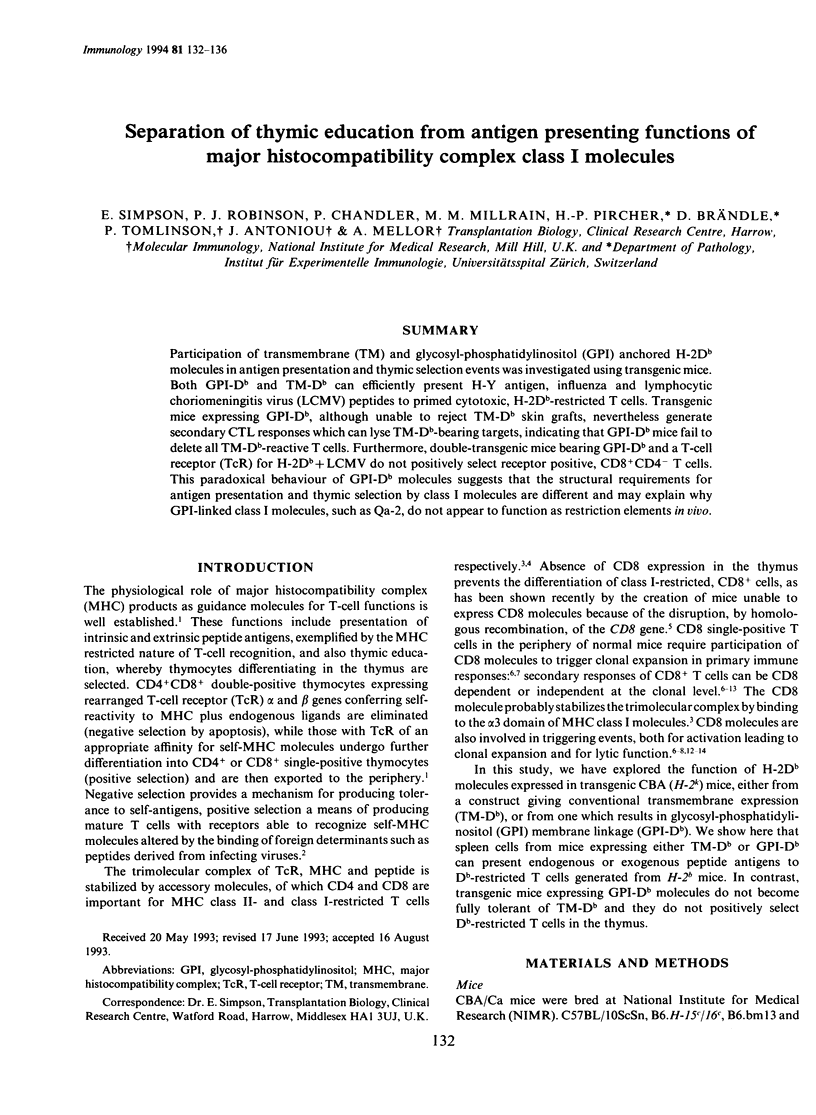
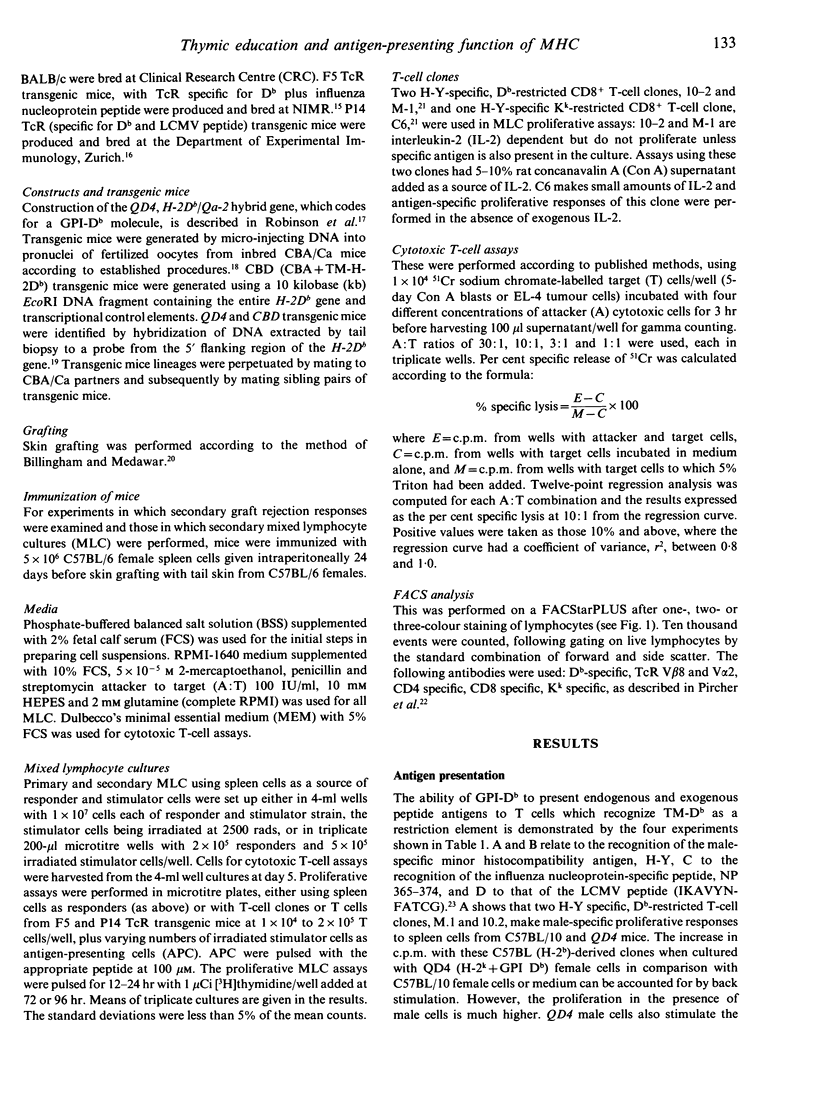
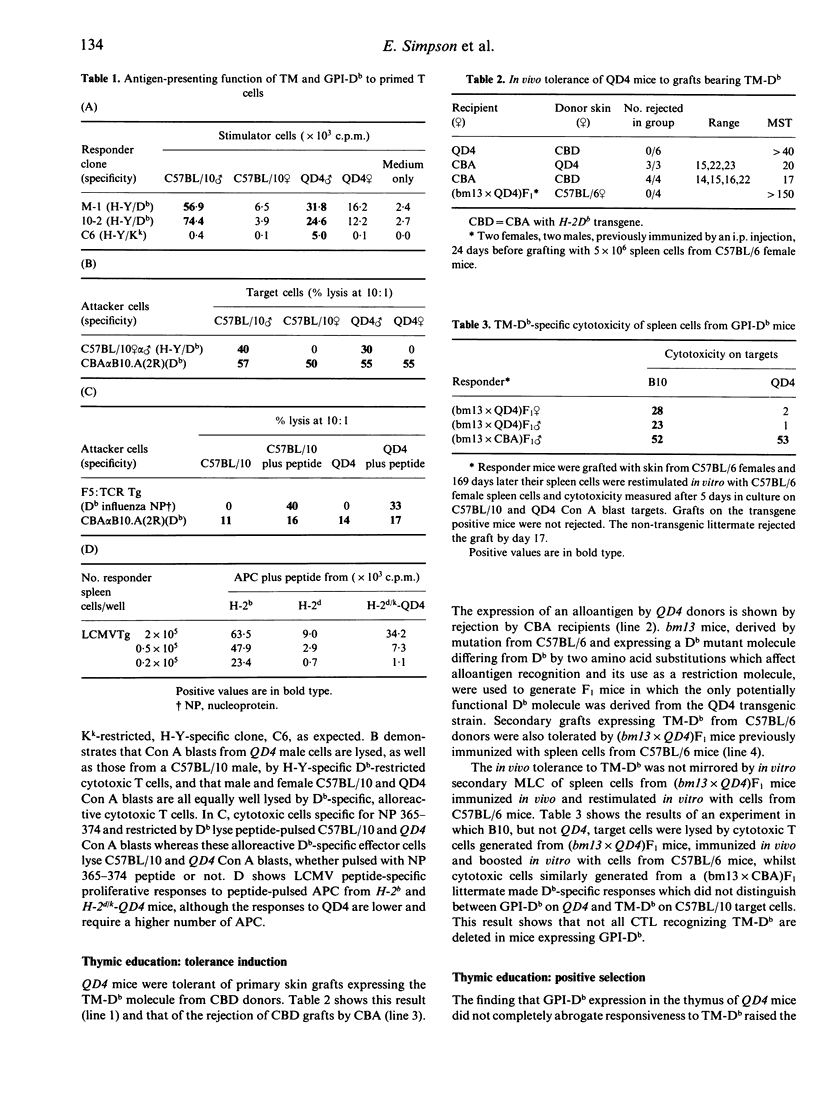
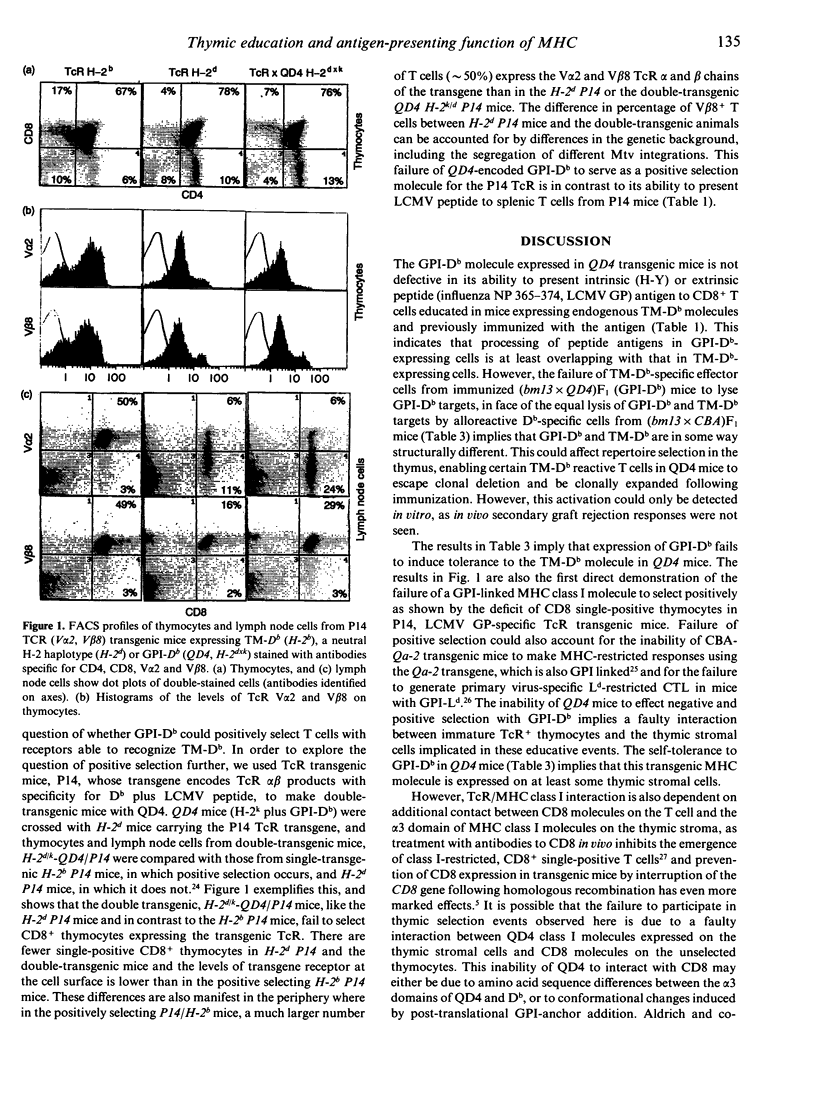
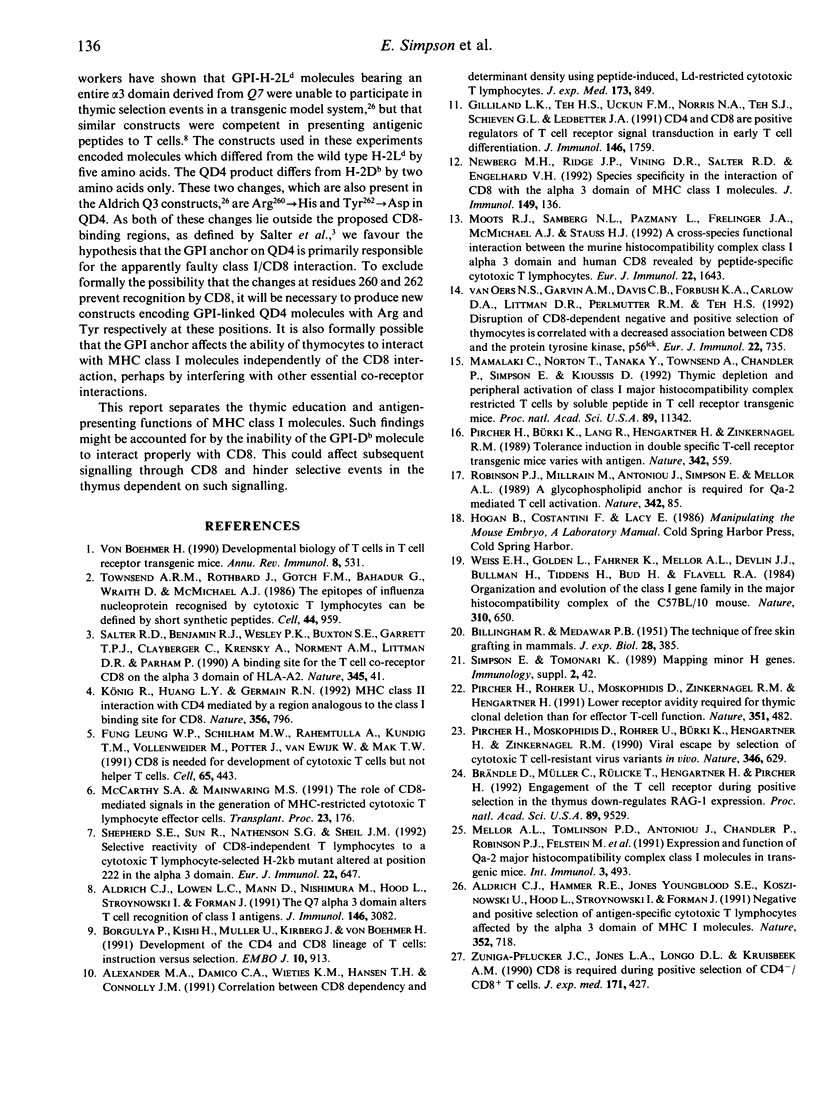
Selected References
These references are in PubMed. This may not be the complete list of references from this article.
- Aldrich C. J., Lowen L. C., Mann D., Nishimura M., Hood L., Stroynowski I., Forman J. The Q7 alpha 3 domain alters T cell recognition of class I antigens. J Immunol. 1991 May 1;146(9):3082–3090. [PubMed] [Google Scholar]
- Alexander M. A., Damico C. A., Wieties K. M., Hansen T. H., Connolly J. M. Correlation between CD8 dependency and determinant density using peptide-induced, Ld-restricted cytotoxic T lymphocytes. J Exp Med. 1991 Apr 1;173(4):849–858. doi: 10.1084/jem.173.4.849. [DOI] [PMC free article] [PubMed] [Google Scholar]
- Borgulya P., Kishi H., Müller U., Kirberg J., von Boehmer H. Development of the CD4 and CD8 lineage of T cells: instruction versus selection. EMBO J. 1991 Apr;10(4):913–918. doi: 10.1002/j.1460-2075.1991.tb08024.x. [DOI] [PMC free article] [PubMed] [Google Scholar]
- Brändle D., Müller C., Rülicke T., Hengartner H., Pircher H. Engagement of the T-cell receptor during positive selection in the thymus down-regulates RAG-1 expression. Proc Natl Acad Sci U S A. 1992 Oct 15;89(20):9529–9533. doi: 10.1073/pnas.89.20.9529. [DOI] [PMC free article] [PubMed] [Google Scholar]
- Fung-Leung W. P., Schilham M. W., Rahemtulla A., Kündig T. M., Vollenweider M., Potter J., van Ewijk W., Mak T. W. CD8 is needed for development of cytotoxic T cells but not helper T cells. Cell. 1991 May 3;65(3):443–449. doi: 10.1016/0092-8674(91)90462-8. [DOI] [PubMed] [Google Scholar]
- Gilliland L. K., Teh H. S., Uckun F. M., Norris N. A., Teh S. J., Schieven G. L., Ledbetter J. A. CD4 and CD8 are positive regulators of T cell receptor signal transduction in early T cell differentiation. J Immunol. 1991 Mar 15;146(6):1759–1765. [PubMed] [Google Scholar]
- König R., Huang L. Y., Germain R. N. MHC class II interaction with CD4 mediated by a region analogous to the MHC class I binding site for CD8. Nature. 1992 Apr 30;356(6372):796–798. doi: 10.1038/356796a0. [DOI] [PubMed] [Google Scholar]
- Mamalaki C., Norton T., Tanaka Y., Townsend A. R., Chandler P., Simpson E., Kioussis D. Thymic depletion and peripheral activation of class I major histocompatibility complex-restricted T cells by soluble peptide in T-cell receptor transgenic mice. Proc Natl Acad Sci U S A. 1992 Dec 1;89(23):11342–11346. doi: 10.1073/pnas.89.23.11342. [DOI] [PMC free article] [PubMed] [Google Scholar]
- McCarthy S. A., Mainwaring M. S. The role of CD8-mediated signals in the generation of MHC-restricted cytotoxic T lymphocyte effector cells. Transplant Proc. 1991 Feb;23(1 Pt 1):176–177. [PubMed] [Google Scholar]
- Mellor A. L., Tomlinson P. D., Antoniou J., Chandler P., Robinson P., Felstein M., Sloan J., Edwards A., O'Reilly L., Cooke A. Expression and function of Qa-2 major histocompatibility complex class I molecules in transgenic mice. Int Immunol. 1991 May;3(5):493–502. doi: 10.1093/intimm/3.5.493. [DOI] [PubMed] [Google Scholar]
- Moots R. J., Samberg N. L., Pazmany L., Frelinger J. A., McMichael A. J., Stauss H. J. A cross-species functional interaction between the murine major histocompatibility complex class I alpha 3 domain and human CD8 revealed by peptide-specific cytotoxic T lymphocytes. Eur J Immunol. 1992 Jun;22(6):1643–1646. doi: 10.1002/eji.1830220645. [DOI] [PubMed] [Google Scholar]
- Newberg M. H., Ridge J. P., Vining D. R., Salter R. D., Engelhard V. H. Species specificity in the interaction of CD8 with the alpha 3 domain of MHC class I molecules. J Immunol. 1992 Jul 1;149(1):136–142. [PubMed] [Google Scholar]
- Pircher H., Bürki K., Lang R., Hengartner H., Zinkernagel R. M. Tolerance induction in double specific T-cell receptor transgenic mice varies with antigen. Nature. 1989 Nov 30;342(6249):559–561. doi: 10.1038/342559a0. [DOI] [PubMed] [Google Scholar]
- Pircher H., Moskophidis D., Rohrer U., Bürki K., Hengartner H., Zinkernagel R. M. Viral escape by selection of cytotoxic T cell-resistant virus variants in vivo. Nature. 1990 Aug 16;346(6285):629–633. doi: 10.1038/346629a0. [DOI] [PubMed] [Google Scholar]
- Robinson P. J., Millrain M., Antoniou J., Simpson E., Mellor A. L. A glycophospholipid anchor is required for Qa-2-mediated T cell activation. Nature. 1989 Nov 2;342(6245):85–87. doi: 10.1038/342085a0. [DOI] [PubMed] [Google Scholar]
- Salter R. D., Benjamin R. J., Wesley P. K., Buxton S. E., Garrett T. P., Clayberger C., Krensky A. M., Norment A. M., Littman D. R., Parham P. A binding site for the T-cell co-receptor CD8 on the alpha 3 domain of HLA-A2. Nature. 1990 May 3;345(6270):41–46. doi: 10.1038/345041a0. [DOI] [PubMed] [Google Scholar]
- Shepherd S. E., Sun R., Nathenson S. G., Sheil J. M. Selective reactivity of CD8-independent T lymphocytes to a cytotoxic T lymphocyte-selected H-2Kb mutant altered at position 222 in the alpha 3 domain. Eur J Immunol. 1992 Mar;22(3):647–653. doi: 10.1002/eji.1830220306. [DOI] [PubMed] [Google Scholar]
- Townsend A. R., Rothbard J., Gotch F. M., Bahadur G., Wraith D., McMichael A. J. The epitopes of influenza nucleoprotein recognized by cytotoxic T lymphocytes can be defined with short synthetic peptides. Cell. 1986 Mar 28;44(6):959–968. doi: 10.1016/0092-8674(86)90019-x. [DOI] [PubMed] [Google Scholar]
- Van Oers N. S., Garvin A. M., Davis C. B., Forbush K. A., Carlow D. A., Littman D. R., Perlmutter R. M., Teh H. S. Disruption of CD8-dependent negative and positive selection of thymocytes is correlated with a decreased association between CD8 and the protein tyrosine kinase, p56lck. Eur J Immunol. 1992 Mar;22(3):735–743. doi: 10.1002/eji.1830220317. [DOI] [PubMed] [Google Scholar]
- Weiss E. H., Golden L., Fahrner K., Mellor A. L., Devlin J. J., Bullman H., Tiddens H., Bud H., Flavell R. A. Organization and evolution of the class I gene family in the major histocompatibility complex of the C57BL/10 mouse. Nature. 1984 Aug 23;310(5979):650–655. doi: 10.1038/310650a0. [DOI] [PubMed] [Google Scholar]
- Zúiga-Pflücker J. C., Jones L. A., Longo D. L., Kruisbeek A. M. CD8 is required during positive selection of CD4-/CD8+ T cells. J Exp Med. 1990 Feb 1;171(2):427–437. doi: 10.1084/jem.171.2.427. [DOI] [PMC free article] [PubMed] [Google Scholar]
- von Boehmer H. Developmental biology of T cells in T cell-receptor transgenic mice. Annu Rev Immunol. 1990;8:531–556. doi: 10.1146/annurev.iy.08.040190.002531. [DOI] [PubMed] [Google Scholar]


